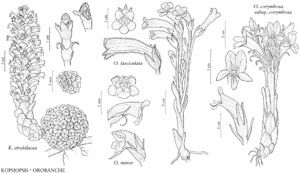Orobanche fasciculata
Gen. N. Amer. Pl. 2: 59. 1818.
Plants branched proximally and/or distally, rarely simple, 6–25(–35) cm (including pedicels), stem portion 1.5–15(–22) cm, slender to moderately stout, base slightly enlarged. Roots inconspicuous, slender or stout, unbranched or few-branched. Leaves few to several, erect or reflexed; blade oblong-ovate to ovate-triangular or awl-shaped, (4–)6–12(–15) mm, margins entire, apex acute or acuminate, surfaces glandular-pubescent distally. Inflorescences fascicles, irregular corymbs, or short racemes of (1–)6–15(–20) flowers at stem or branch tips, light yellow to yellow or tinged pinkish to reddish purple, simple, densely glandular-pubescent, sometimes glabrescent proximally; bracts erect or ± spreading, oblanceolate to oblong, lanceolate, or awl-shaped, sometimes ovate, 7–12 mm, apex acute, sometimes acuminate, moderately to densely glandular-pubescent. Pedicels 10–70(–150) mm, proximal as long as or ± longer than plant axis, distal sometimes shorter; bracteoles 0. Flowers: calyx light yellow to orangish yellow, tan, or grayish tan, often purplish tinged distally, sometimes entirely pinkish purple to reddish purple or dark purple, ± radially symmetric, (4–)6–12(–18) mm, divided into 5 subequal lobes, lobes shorter than to slightly longer than tube, triangular to subulate-triangular, moderately to densely glandular-pubescent; corolla (11–)14–30(–38) mm, tube white to cream or yellow, purplish tinged, or pinkish purple to reddish purple, sometimes with darker pink, purple, or brown veins, slightly to moderately constricted above ovary, ± bent forward, glabrate or glandular-pubescent; palatal folds ± prominent, usually yellow, moderately to densely glandular-pubescent; lips yellow or pinkish purple to reddish purple, rarely white, sometimes with darker purple veins, abaxial lip ± spreading, 3–6(–9) mm, lobes oblong-obovate to nearly round, sometimes oblong-elliptic, apex rounded or ± pointed, sometimes shallowly emarginate, adaxial lip slightly to moderately spreading or recurved, (2–)3–6(–9) mm, lobes oblong-ovate to nearly round, sometimes oblong-elliptic, apex rounded or ± pointed; filaments glabrous, anthers included, glabrous or villous-tomentose. Capsules ovoid to oblong-ovoid, 6–12 mm. Seeds 0.2–0.5 mm. 2n = 48.
Phenology: Flowering Apr–Aug.
Habitat: Sagebrush, chaparral, upland prairies, dunes, desert scrub, rocky slopes, hardwood and coniferous woodlands and forests, thickets, alpine meadows, roadsides, gardens.
Elevation: 150–3300 m.
Distribution
Alta., B.C., Man., Ont., Sask., Yukon, Alaska, Ariz., Calif., Colo., Idaho, Ill., Ind., Iowa, Kans., Mich., Minn., Mont., Nebr., Nev., N.Mex., N.Dak., Okla., Oreg., S.Dak., Tex., Utah, Wash., Wis., Wyo., Mexico (Baja California, Chihuahua).
Discussion
Similar to Orobanche uniflora, O. fasciculata forms a polymorphic complex that may involve cryptic species. However, unlike O. uniflora, infraspecific taxa in O. fasciculata lack strong correlations with morphology, geography, and host ranges; they are not recognized here. Previously, D. M. Achey (1933) separated the species into three varieties based mainly on plant color and flower size. In her unpublished thesis, K. C. Watson (1975) expanded this to four subspecies but circumscribed her taxa differently. Both authors noted morphological overlap among taxa.
Of particular interest is a series of populations from California and adjacent Oregon [always parasitic on Galium (Rubiaceae)] to which Watson applied the manuscript name "subsp. uniflorioides" and that, in many ways, are morphologically intermediate between Orobanche fasciculata and O. uniflora. Recently, A. E. L. Colwell et al. (2017) segregated these under the name Aphyllon epigalium Colwell & A. C. Schneider. They are distinctive in having typically two to four flowers per stem, usually cream to yellow corollas (sometimes tinged with pink or purple), including the palatal folds, and glandular (versus ciliolate) corolla margins. Colwell et al. went further in subdividing their new species into two subspecies, segregating plants with somewhat smaller, cream-colored corollas having at most slightly recurved lips as subsp. notocalifornicum A. C. Schneider & Colwell and retaining plants with somewhat larger, yellow corollas with spreading lobes as subsp. epigalium. This treatment is tentative, pending further research into the population genetics within the entire complex.
Most references suggest that Orobanche fasciculata uses a broad range of hosts. However, there are four main genera of host plants: Artemisia (Asteraceae), Phacelia (Hydrophyllaceae), Eriodictyon (Namaceae), and Eriogonum (Polygonaceae). As noted above, a morphologically distinctive set of populations parasitizes Galium. Other less commonly reported hosts include Ericameria and Eriophyllum (Asteraceae), Atriplex and Grayia (Chenopodiaceae), Convolvulus (Convolvulaceae), Arctostaphylos (Ericaceae), Mirabilis (Nyctaginaceae), Pinus (Pinaceae), grasses (Poaceae), Delphinium (Ranunculaceae), Adenostoma, Prunus, and Purshia (Rosaceae), and Vitis (Vitaceae). Some minor hosts are listed based only on specimen label data and require confirmation.
Selected References
None.
